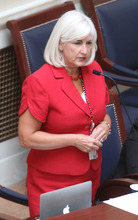This is an archived article that was published on sltrib.com in 2013, and information in the article may be outdated. It is provided only for personal research purposes and may not be reprinted.
State Sen. Pat Jones says she is tired of education policies that pit parents against public schools. She is deaf to debates over who among Utah's 601,000 schoolchildren are most deserving.
All children deserve a quality education, every school in the state needs help – and it's going to take every resident pulling together to deliver it, said the Holladay Democrat. "It's time we said, 'Let's all contribute to making Utah's educational system great. Let's invest in our kids.' "
Jones is proposing to raise $400 million in new, ongoing funding for Utah schools by eliminating a popular tax exemption that favors large families.
Her bill, scheduled to be aired at the Education Interim Committee in October, would not raise the income tax rate. The rate would stay at 5 percent, which few pay due to the myriad tax write-offs available for mortgages and church and charitable giving, Jones noted.
Rather, the bill would do away with one of those tax breaks, the personal income tax exemption that workers claim for themselves and their dependents, she said.
Doing so would amount to a $500 tax hike for the average household. Large families would be especially hard-hit. Some pay no income tax, making the plan a hard sell in Utah's conservative, tax-averse Legislature.
"A $400 million tax hike would be the largest increase the state has ever seen," said Royce Van Tassell, vice president of the Utah Taxpayers Association. "It's a good way to convince businesses to invest in Idaho, Colorado or Wyoming."
But Jones begs to differ, arguing that employers want educated workers and framing her bill as a boon to the economy.
Preliminary data from the Legislative Fiscal Analyst show the measure would create 10,000 jobs, most of them in education, she said. "Jobs that help kids and jobs that stay in our communities rather than being shipped outside the state."
Goals to boost reading and math scores and graduation rates, set by Utah's business-led Prosperity 2020 coalition, are estimated to cost $400 million.
That's "the magic figure" schools need to reduce classroom sizes and hire reading specialists, teachers' aides and guidance counselors, she said, noting she's open to other funding mechanisms.
Jones' proposal would yield an extra $400,000 per elementary school and $700,000 to $1 million per secondary school each year, and it embraces another conservative ideal: local control.
The money would go directly to schools, instead of passing through the state Office of Education, and it would be spent however local School Community Councils see fit.
In addition, 10 percent would be taken off the top and distributed evenly statewide, ensuring that charter schools and rural communities get their fair share, Jones said. The rest of the funds would be distributed by student population.
Jones says it's a fairer, flatter approach to taxation as no one receives preferential treatment and everyone shoulders the burden, making it easier to bear. She likens the ethic to barn raisings from pioneer days. "When it was finished, it was Mr. Johnson's barn, but everyone contributed and next time it was someone else's turn," she said.
Sen. Aaron Osmond, R-South Jordan, likes the concept of any new funding going directly to local schools.
"I know my constituents wouldn't favor a tax increase unless they know they'll have control over how it's spent," he said.
But he's reserving judgement until he's sure the plan wouldn't absolve some taxpayers of their social responsibility to back schools.
Van Tassell said revisiting the personal tax exemption is worthwhile, but argues, "we should put all the credits and exemptions on the table and ask which ones make economic sense and which ones improve the state."
Research has shown more school spending doesn't improve learning, including in Utah, where student scores are flat despite doubling of per-pupil spending from 1970 to 2010.



